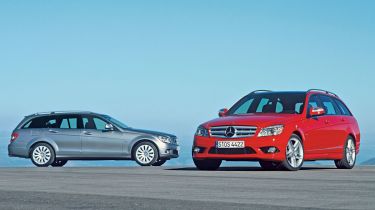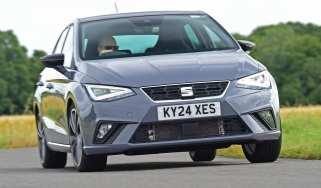Mercedes C-Class
This new load-lugger may have the space advantage over a 3-Series, but will that be enough to steer buyers into one?

The handsome C-Class load-lugger isn’t quite as sporty in profile as some of its competitors, but open the tailgate and its key strengths can soon be found within the spacious and well planned luggage area. There are plenty of thoughtful touches to be found elsewhere in the interior, too, which should help to justify the anticipated high purchase prices; when the C-Class arrives in the UK in summer next year, it’s expected to cost more than £23,000, even in its most basic guise.
Here’s the reason Mercedes reckons its C-Class is loads better than the BMW 3-Series. When the new estate version arrives next summer, it will boast the biggest boot in its sector.
Fortunately, the engineering changes required to achieve this have not compromised the car’s styling – and the newcomer looks every bit as purposeful as the standard saloon. Smooth, flowing lines arc along its flanks into a rounded rear, giving a sleek appearance despite the upright tailgate.
And the luggage area is as practical as it is stylish. You’ll quickly find the 485-litre boot can be boosted to 1,500 litres by folding the split rear seat. This is an increase of up to 146 litres over the old model – and is comparable to a Volvo V70, which carries a maximum of 1,600 litres. The arrangement promises to be extremely safe, too: in recognition of the dangers posed by heavy luggage flying about in a crash, Mercedes has worked hard to strengthen the rear seatbacks.
In addition, it offers an improved ‘Easy-Pack’ load-securing kit, which is much simpler to use than the old system. An optional electric tailgate and panoramic sunroof are also available – both firsts in this sector, according to the German manufacturer – while bespoke cabin trim will now see the boot carpet and plastics share the same colour.
A repositioned back seat gives occupants more kneeroom, and extra comfort comes courtesy of optional three-zone climate control, again a class first. Finally, the engine range mirrors that of the saloon car, and includes supercharged four-cylinder and V6 petrol units, plus CDI diesels in the same configurations. We drove the 2.2-litre C220 CDI, which performed just as well as the saloon. Its 170bhp and 400Nm give it a muscular feel; important, as some C-Class estates can tow up to 1,800kg, more than any rival. Combined economy of 46.3mpg also impresses.
The optional self-levelling suspension includes electronically controlled dampers, which meant our model was highly stable over uneven surfaces. Steering feel is also good, and the disc brakes powerful and consistent.
Perhaps most impressive, however, is motorway refinement. Despite the huge rear compartment, wind and road noise are extremely well controlled, and the estate seems just as luxurious as the saloon. So, are there any drawbacks? Well, the C-Class certainly doesn’t come cheap, with our model expected to cost around £29,000.
The other potential fly in the ointment is likely to be Audi’s new A4 Avant. Set to arrive soon after the Mercedes, it could prove to be the class champion – particularly if it lives up to the promise of the saloon.
Rival: BMW 3-Series Touring
The more racy BMW has a slightly smaller boot than the Mercedes with the rear seats in place, and its 460 litres expand to a mere 1,385 litres with them folded down – 115 less than in the C-Class. Neither is the load area as practical. However, the 3-Series is the sportier drive, and around £1,000 cheaper than the Mercedes.







